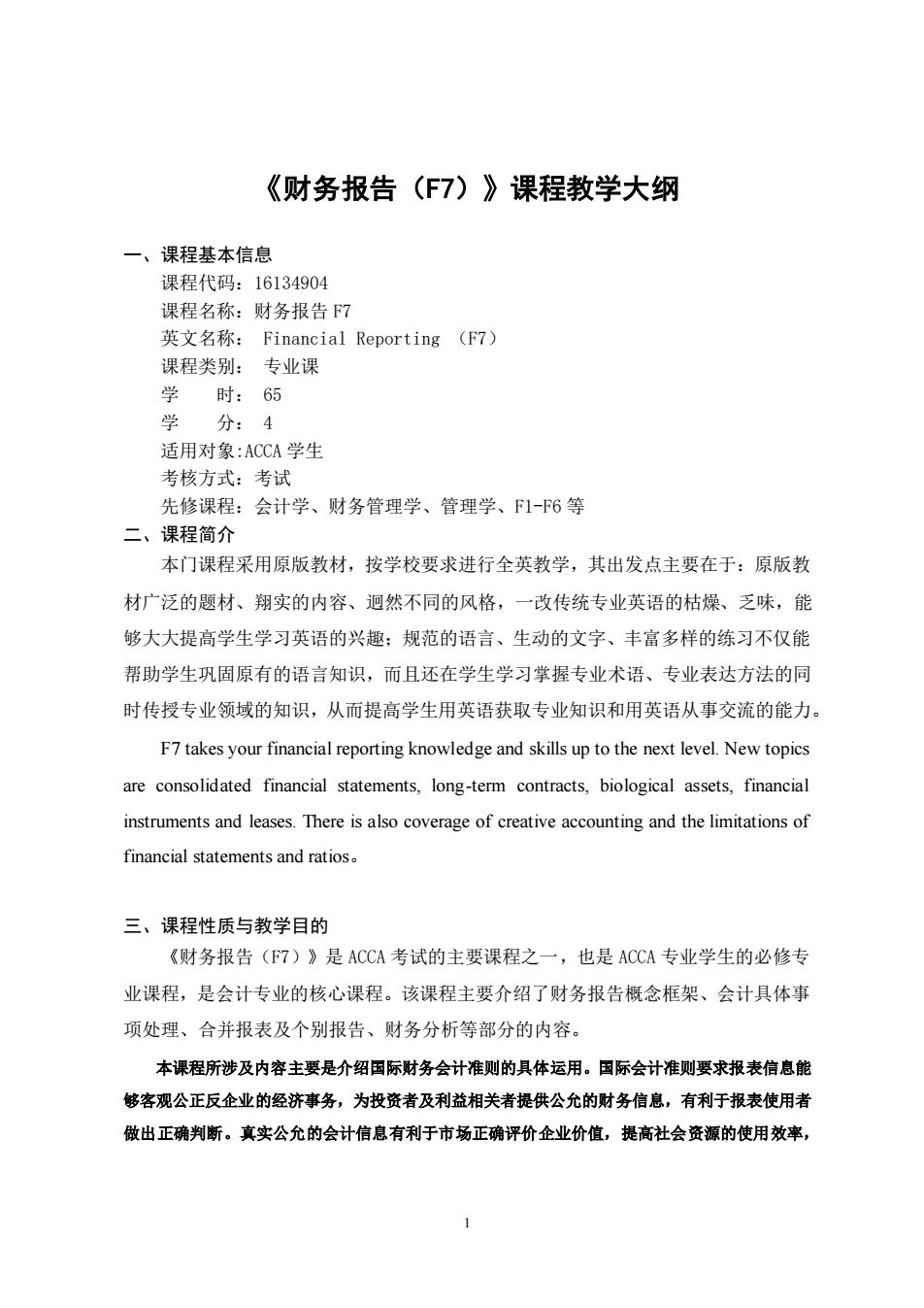
《财务报告(F7)》课程教学大纲 一、课程基本信息 课程代码:16134904 课程名称:财务报告F7 英文名称:Financial Reporting(F) 课程类别:专业课 时:65 学分:4 适用对象:ACCA学生 考核方式:考试 先修课程:会计学、财务管理学、管理学、F1-F6等 二、课程简介 本门课程采用原版教材,按学校要求进行全英教学,其出发点主要在于:原版教 材广泛的题材、翔实的内容、迥然不同的风格,一改传统专业英语的枯燥、乏味,能 够大大提高学生学习英语的兴趣:规范的语言、生动的文字、丰富多样的练习不仅能 帮助学生巩固原有的语言知识,而且还在学生学习掌握专业术语、专业表达方法的同 时传授专业领域的知识,从而提高学生用英语获取专业知识和用英语从事交流的能力。 F7 takes your financial reporting knowledge and skills up to the next level.New topics are consolidated financial statements,long-term contracts,biological assets,financial instruments and leases.There is also coverage of creative accounting and the limitations of financial statements and ratios. 三、课程性质与教学目的 《财务报告(F7)》是ACCA考试的主要课程之一,也是ACCA专业学生的必修专 业课程,是会计专业的核心课程。该课程主要介绍了财务报告概念框架、会计具体事 项处理、合并报表及个别报告、财务分析等部分的内容。 本课程所涉及内容主要是介绍国际财务会计准则的具体运用。国际会计准则要求报表信息能 够客观公正反企业的经济事务,为投资者及利益相关者提供公允的财务信息,有利于报表使用者 做出正确判断。真实公允的会计信息有利于市场正确评价企业价值,提高社会资源的使用效率
1 《财务报告(F7)》课程教学大纲 一、课程基本信息 课程代码:16134904 课程名称:财务报告 F7 英文名称: Financial Reporting (F7) 课程类别: 专业课 学 时: 65 学 分: 4 适用对象:ACCA 学生 考核方式:考试 先修课程:会计学、财务管理学、管理学、F1-F6 等 二、课程简介 本门课程采用原版教材,按学校要求进行全英教学,其出发点主要在于:原版教 材广泛的题材、翔实的内容、迥然不同的风格,一改传统专业英语的枯燥、乏味,能 够大大提高学生学习英语的兴趣;规范的语言、生动的文字、丰富多样的练习不仅能 帮助学生巩固原有的语言知识,而且还在学生学习掌握专业术语、专业表达方法的同 时传授专业领域的知识,从而提高学生用英语获取专业知识和用英语从事交流的能力。 F7 takes your financial reporting knowledge and skills up to the next level. New topics are consolidated financial statements, long-term contracts, biological assets, financial instruments and leases. There is also coverage of creative accounting and the limitations of financial statements and ratios。 三、课程性质与教学目的 《财务报告(F7)》是 ACCA 考试的主要课程之一,也是 ACCA 专业学生的必修专 业课程,是会计专业的核心课程。该课程主要介绍了财务报告概念框架、会计具体事 项处理、合并报表及个别报告、财务分析等部分的内容。 本课程所涉及内容主要是介绍国际财务会计准则的具体运用。国际会计准则要求报表信息能 够客观公正反企业的经济事务,为投资者及利益相关者提供公允的财务信息,有利于报表使用者 做出正确判断。真实公允的会计信息有利于市场正确评价企业价值,提高社会资源的使用效率
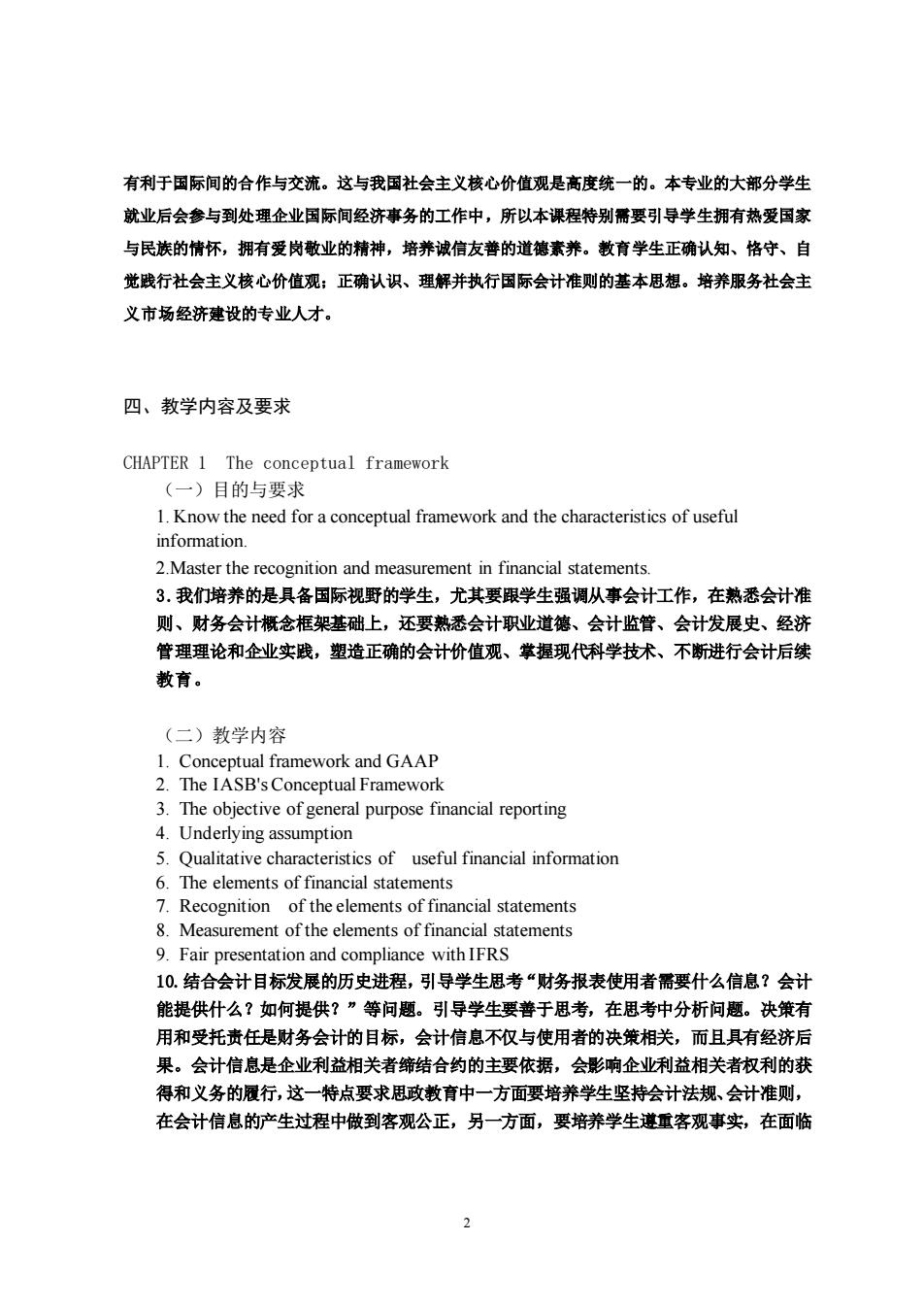
有利于国际间的合作与交流。这与我国社会主义核心价值观是高度统一的。本专业的大部分学生 就业后会参与到处理企业国际间经济事务的工作中,所以本课程特别需要引导学生拥有热爱国家 与民族的情怀,拥有爱岗敢业的精神,培养诚信友善的道德素养。教育学生正确认知、格守、自 觉践行社会主义核心价值观;正确认识、理解并执行国际会计准则的基本思想。培养服务社会主 义市场经济建设的专业人才。 四、教学内容及要求 CHAPTER 1 The conceptual framework (一)目的与要求 1.Know the need for a conceptual framework and the characteristics of useful 2 Master the recognition and measurement in financial statements. 3.我们培养的是具备国际视野的学生,尤其要跟学生强调从事会计工作,在熟悉会计准 则、财务会计概念框架基础上,还要熟悉会计职业道德、会计监管、会计发展史、经济 管理理论和企业实践,塑造正确的会计价值观、举握现代科学技术、不断进行会计后续 教育。 (二)教学内容 uframework and GAAP 3.The objective of general purpose financial reporting 4.Underlving assumption 5.Qualitative characteristics of useful financial information 6.The elem nts of fir nancial stat 7.Recognition of the elements of financial statement 8.Measurement of the elements of financial statements 9.Fair presentation and compliance with ifrs 10.结合会计目标发展的历史进程,引导学生思考“财务报表使用者需要什么信息?会计 能提供什么?如何提供?”等问题。引导学生要善于思考,在思考中分析问题。决策有 用和受托责任是财务会计的目标,会计信息不仅与使用者的决策相关,而且具有经济后 果。会计信息是企业利益相关者缔结合约的主要依据,会影响企业利益相关者权利的获 得和义务的履行,这一特点要求思政教育中一方面要培养学生坚持会计法规、会计准则, 在会计信息的产生过程中做到客观公正,另一方面,要培养学生遵重客观事实,在面临 2
2 有利于国际间的合作与交流。这与我国社会主义核心价值观是高度统一的。本专业的大部分学生 就业后会参与到处理企业国际间经济事务的工作中,所以本课程特别需要引导学生拥有热爱国家 与民族的情怀,拥有爱岗敬业的精神,培养诚信友善的道德素养。教育学生正确认知、恪守、自 觉践行社会主义核心价值观;正确认识、理解并执行国际会计准则的基本思想。培养服务社会主 义市场经济建设的专业人才。 四、教学内容及要求 CHAPTER 1 The conceptual framework (一)目的与要求 1. Know the need for a conceptual framework and the characteristics of useful information. 2.Master the recognition and measurement in financial statements. 3 .我们培养的是具备国际视野的学生,尤其要跟学生强调从事会计工作,在熟悉会计准 则、财务会计概念框架基础上,还要熟悉会计职业道德、会计监管、会计发展史、经济 管理理论和企业实践,塑造正确的会计价值观、掌握现代科学技术、不断进行会计后续 教育。 (二)教学内容 1. Conceptual framework and GAAP 2. The IASB's Conceptual Framework 3. The objective of general purpose financial reporting 4. Underlying assumption 5. Qualitative characteristics of useful financial information 6. The elements of financial statements 7. Recognition of the elements of financial statements 8. Measurement of the elements of financial statements 9. Fair presentation and compliance with IFRS 10.结合会计目标发展的历史进程,引导学生思考“财务报表使用者需要什么信息?会计 能提供什么?如何提供?”等问题。引导学生要善于思考,在思考中分析问题。决策有 用和受托责任是财务会计的目标,会计信息不仅与使用者的决策相关,而且具有经济后 果。会计信息是企业利益相关者缔结合约的主要依据,会影响企业利益相关者权利的获 得和义务的履行,这一特点要求思政教育中一方面要培养学生坚持会计法规、会计准则, 在会计信息的产生过程中做到客观公正,另一方面,要培养学生遵重客观事实,在面临

不确定性,学会运用实事求是方法论,公允地进行会计核算和信息披露。 11.通过讲解会计信息的特点,引导学生理解会计真实表达的含义,说明诚信品质在会计 表达中的重要性 (三)思考与实践 1.Define a'conceptual framework' 2.What are the advantages and disadvantages of developing a conceptual framework? 3.The needs of which category of user are paramount when preparing financial statements? 4.Understandability,relevance,reliability and comparability. 5 The con of'fai hfu rep (in e and fair view) th eexistence of a regulatory framework? (四)教学方法与手段 本章教学主要采用的方法和手段是传统教学与多媒体教学或者投影相结合。 对会计概念框架问题,利用多媒体教学手段,采 一些图示进行的教学讲解,同 时也是对学生学习方法和思路进行的提示和指导。 结合案例、论文来进行讨论分析。培养学生善于思考,在思考中分析问题。 分析不出所以然,就解决不了实际问题。理论来源于实践,反过来又指导实践。 通过探讨会计实务其中的会计理论问题,思考会计理论的可能的改进之处,为会 计信息使用者提供决策有用的信息。 CHAPTER 2 The regulatory framework (一)目的与要求 the regulatory m 2.通过讲解国际会计准则的制定思想,介绍国际间合作与交流的必要,以及举握国际会 计准则对我国经济发展的重要性。 (一)教学内容 a reg orting Standards(IFRS) 3.通过介绍国际会计准则的制定规则与程序,解释随着社会经济的发展与变革,会计准 则需要不断的修订与发展,要成为一个合格的国际财务工作者,需要在今后的工作中需 要不断学习,提升职业素养。 3
3 不确定性,学会运用实事求是方法论,公允地进行会计核算和信息披露。 11.通过讲解会计信息的特点,引导学生理解会计真实表达的含义,说明诚信品质在会计 表达中的重要性. (三)思考与实践 1. Define a ‘conceptual framework’. 2. What are the advantages and disadvantages of developing a conceptual framework? 3. The needs of which category of user are paramount when preparing financial statements? 4. Understandability, relevance, reliability and comparability. 5. The concept of 'faithful representation' ('true and fair view') 6. Reasons for the existence of a regulatory framework? (四)教学方法与手段 本章教学主要采用的方法和手段是传统教学与多媒体教学或者投影相结合。 对会计概念框架问题,利用多媒体教学手段,采用一些图示进行的教学讲解,同 时也是对学生学习方法和思路进行的提示和指导。 结合案例、论文来进行讨论分析。培养学生善于思考,在思考中分析问题。 分析不出所以然,就解决不了实际问题。理论来源于实践,反过来又指导实践。 通过探讨会计实务其中的会计理论问题,思考会计理论的可能的改进之处,为会 计信息使用者提供决策有用的信息。 CHAPTER 2 The regulatory framework (一)目的与要求 1.Know the regulatory framework. 2 .通过讲解国际会计准则的制定思想,介绍国际间合作与交流的必要,以及掌握国际会 计准则对我国经济发展的重要性。 (二)教学内容 1. The need for a regulatory framework 2. Setting of International Financial Reporting Standards (IFRS) 3. 通过介绍国际会计准则的制定规则与程序,解释随着社会经济的发展与变革,会计准 则需要不断的修订与发展,要成为一个合格的国际财务工作者,需要在今后的工作中需 要不断学习,提升职业素养
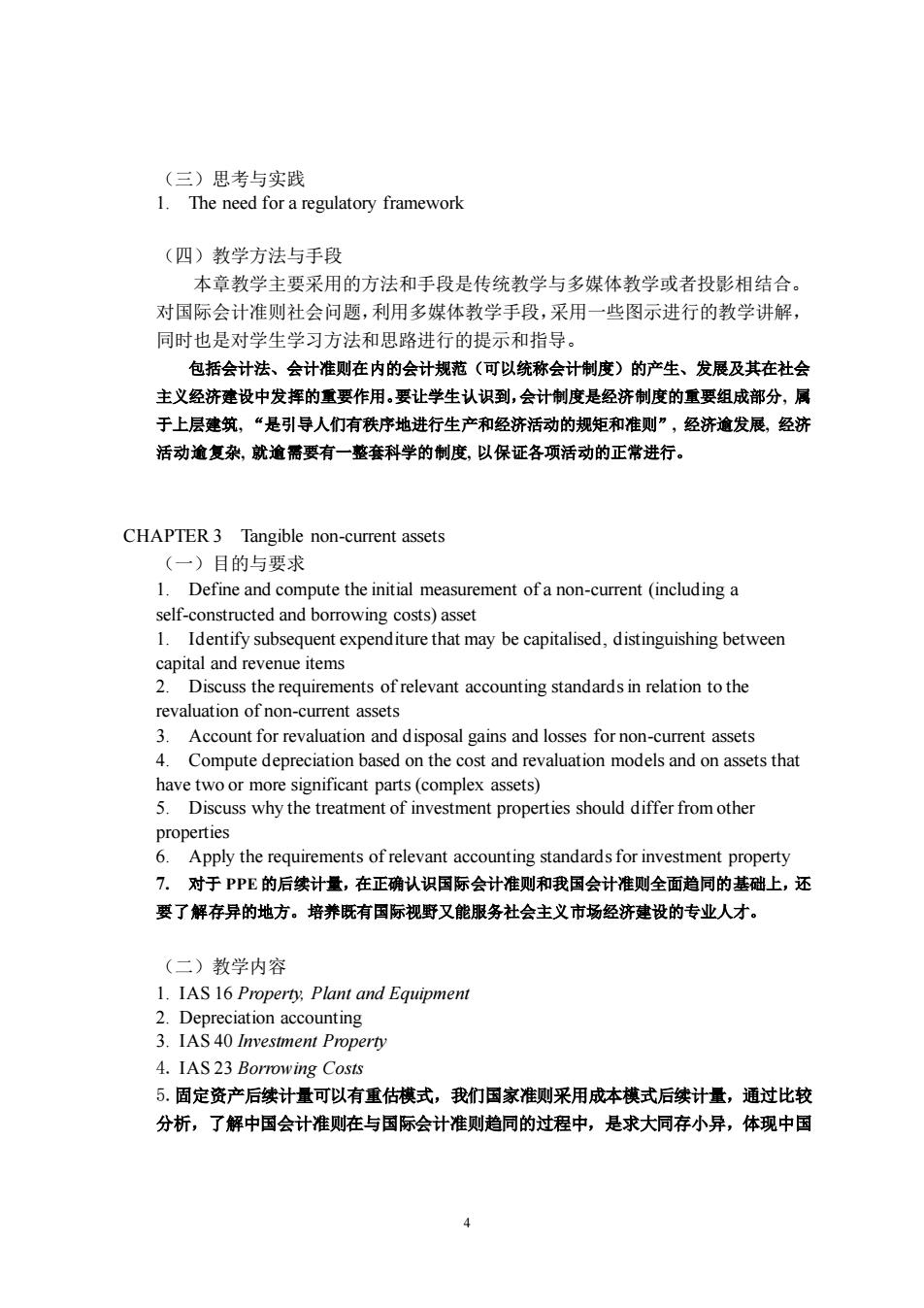
(三)思考与实践 1 The need for a regulatory framework (四)教学方法与手段 本章教学主要采用的方法和手段是传统教学与多媒体教学或者投影相结合 对国际会计准则社会问题,利用多媒体教学手段,采用一些图示进行的教学讲解, 同时也是对学生学习方法和思路进行的提示和指导。 包括会计法、会计准则在内的会计规范(可以统称会计制度)的产生、发展及其在社会 主义经济建设中发挥的重要作用,要让学生认识到,会计制度是经济制度的重要组成部分,属 于上层建筑,“是引导人们有秩序地进行生产和经济活动的规矩和准则”,经济逾发展,经济 活动逾复杂,就逾需要有一整套科学的制度,以保证各项活动的正常进行。 CHAPTER 3 Tangible non-current assets (一)目的与要求 1.Define and compute the initial measurement of a non-current (including a self-constructed and borrowing costs)asset 1. Identify subsequent expenditure that may be capitalised.distinguishing between capital and revenue items 2.Discuss the requirements of relevant accounting standards in relation to the revaluation of non-current assets 3.Account for revaluation and disposal gains and losses for non-current assets 4.Compute deprec at on bas sed o n the cost an dels d on assets that have two or more significant parts(complex assets) 5.Discuss why the treatment of investment properties should differ from othe properties 6.Apply the requirements of relevant accounting standards for investment property 7。对于PPE的后续计量,在正确认识国际会计准则和我同会计准则全面趋同的基础上,还 要了解存异的地方。培养既有国际视野又能服务社会主义市场经济建设的专业人才。 (一)教学内容 1.IAS 16 Property.Plant and Equipment 2 Depreciation accounting 3.IAS 40 Investment Property 4.IAS 23 Borrowing Costs 5.固定资产后续计量可以有重估模式,我们国家准则采用成本模式后续计量,通过比较 分析,了解中国会计准则在与国际会计准则趋同的过程中,是求大同存小异,体现中国
4 (三)思考与实践 1. The need for a regulatory framework (四)教学方法与手段 本章教学主要采用的方法和手段是传统教学与多媒体教学或者投影相结合。 对国际会计准则社会问题,利用多媒体教学手段,采用一些图示进行的教学讲解, 同时也是对学生学习方法和思路进行的提示和指导。 包括会计法、会计准则在内的会计规范(可以统称会计制度)的产生、发展及其在社会 主义经济建设中发挥的重要作用。要让学生认识到,会计制度是经济制度的重要组成部分, 属 于上层建筑, “是引导人们有秩序地进行生产和经济活动的规矩和准则”, 经济逾发展, 经济 活动逾复杂, 就逾需要有一整套科学的制度, 以保证各项活动的正常进行。 CHAPTER 3 Tangible non-current assets (一)目的与要求 1. Define and compute the initial measurement of a non-current (including a self-constructed and borrowing costs) asset 1. Identify subsequent expenditure that may be capitalised, distinguishing between capital and revenue items 2. Discuss the requirements of relevant accounting standards in relation to the revaluation of non-current assets 3. Account for revaluation and disposal gains and losses for non-current assets 4. Compute depreciation based on the cost and revaluation models and on assets that have two or more significant parts (complex assets) 5. Discuss why the treatment of investment properties should differ from other properties 6. Apply the requirements of relevant accounting standards for investment property 7. 对于 PPE 的后续计量,在正确认识国际会计准则和我国会计准则全面趋同的基础上,还 要了解存异的地方。培养既有国际视野又能服务社会主义市场经济建设的专业人才。 (二)教学内容 1. IAS 16 Property, Plant and Equipment 2. Depreciation accounting 3. IAS 40 Investment Property 4. IAS 23 Borrowing Costs 5.固定资产后续计量可以有重估模式,我们国家准则采用成本模式后续计量,通过比较 分析,了解中国会计准则在与国际会计准则趋同的过程中,是求大同存小异,体现中国
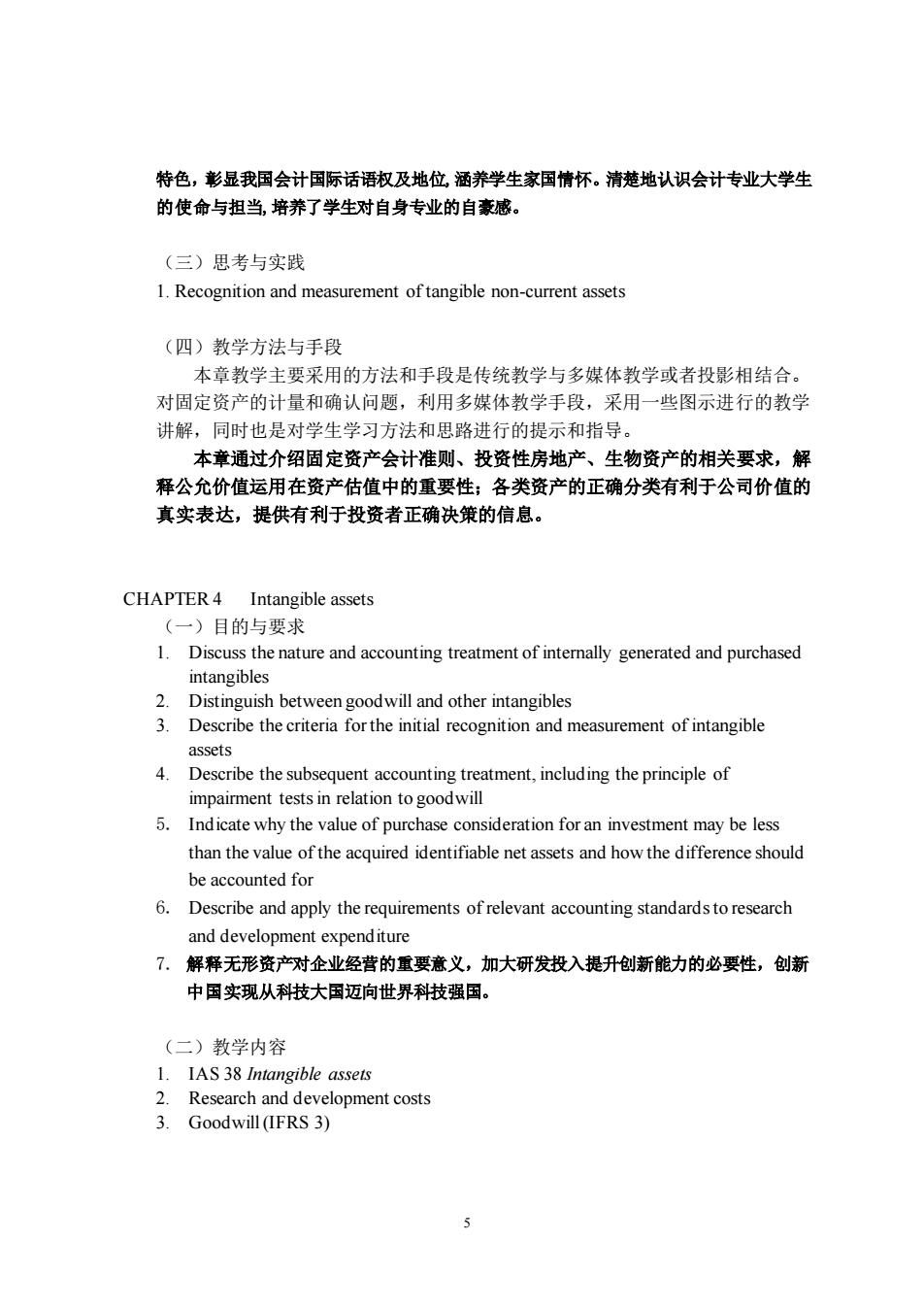
特色,彰显我国会计国际话语权及地位通养学生家国情怀。清楚地认识会计专业大学生 的使命与担当,培养了学生对自身专业的自豪感。 (三)思考与实践 1.Recognition and measurement of tangible non-current assets (四)教学方法与手段 本章教学主要采用的方法和手段是传统教学与多媒体教学或者投影相结合。 对固定资产的计量和确认问题,利用多媒体教学手段,采用一些图示进行的教学 讲解,同时也是对学生学习方法和思路进行的提示和指导。 本章通过介绍固定资产会计准则、投资性房地产、生物资产的相关要求,解 释公允价值运用在资产估值中的重要性;各类资产的正确分类有利于公司价值的 真实表达,提供有利于投资者正确决策的信息。 CHAPTER 4 Intangible assets (一)目的与要求 1.Discuss the nature and accounting treatment of internally generated and purchased intangibles 2 Distinguish between good will and other intangibles 3 Describe the criteria for the initial recognition and measurement of intangible assets Describe the subsequent accounting treatment,including the principle of impairment tests in relation to goodwill 5.Indicate why the value of purchase consideration for an investment may be less than the value of the acquired identifiable net assets and how the difference should be accounted for 6. Describe and apply the requirements of relevant accounting standards to research and development expenditure 7.解释无形资产对企业经营的重要意义,加大研发投入提升创新能力的必要性,创新 中国实现从科技大国迈向世界科技强国。 (二)教学内容 1.IAS 38 Intangible assets 2.Research and development costs 3.Goodwill (IFRS 3)
5 特色,彰显我国会计国际话语权及地位,涵养学生家国情怀。清楚地认识会计专业大学生 的使命与担当,培养了学生对自身专业的自豪感。 (三)思考与实践 1. Recognition and measurement of tangible non-current assets (四)教学方法与手段 本章教学主要采用的方法和手段是传统教学与多媒体教学或者投影相结合。 对固定资产的计量和确认问题,利用多媒体教学手段,采用一些图示进行的教学 讲解,同时也是对学生学习方法和思路进行的提示和指导。 本章通过介绍固定资产会计准则、投资性房地产、生物资产的相关要求,解 释公允价值运用在资产估值中的重要性;各类资产的正确分类有利于公司价值的 真实表达,提供有利于投资者正确决策的信息。 CHAPTER 4 Intangible assets (一)目的与要求 1. Discuss the nature and accounting treatment of internally generated and purchased intangibles 2. Distinguish between goodwill and other intangibles 3. Describe the criteria for the initial recognition and measurement of intangible assets 4. Describe the subsequent accounting treatment, including the principle of impairment tests in relation to goodwill 5. Indicate why the value of purchase consideration for an investment may be less than the value of the acquired identifiable net assets and how the difference should be accounted for 6. Describe and apply the requirements of relevant accounting standards to research and development expenditure 7. 解释无形资产对企业经营的重要意义,加大研发投入提升创新能力的必要性,创新 中国实现从科技大国迈向世界科技强国。 (二)教学内容 1. IAS 38 Intangible assets 2. Research and development costs 3. Goodwill (IFRS 3)
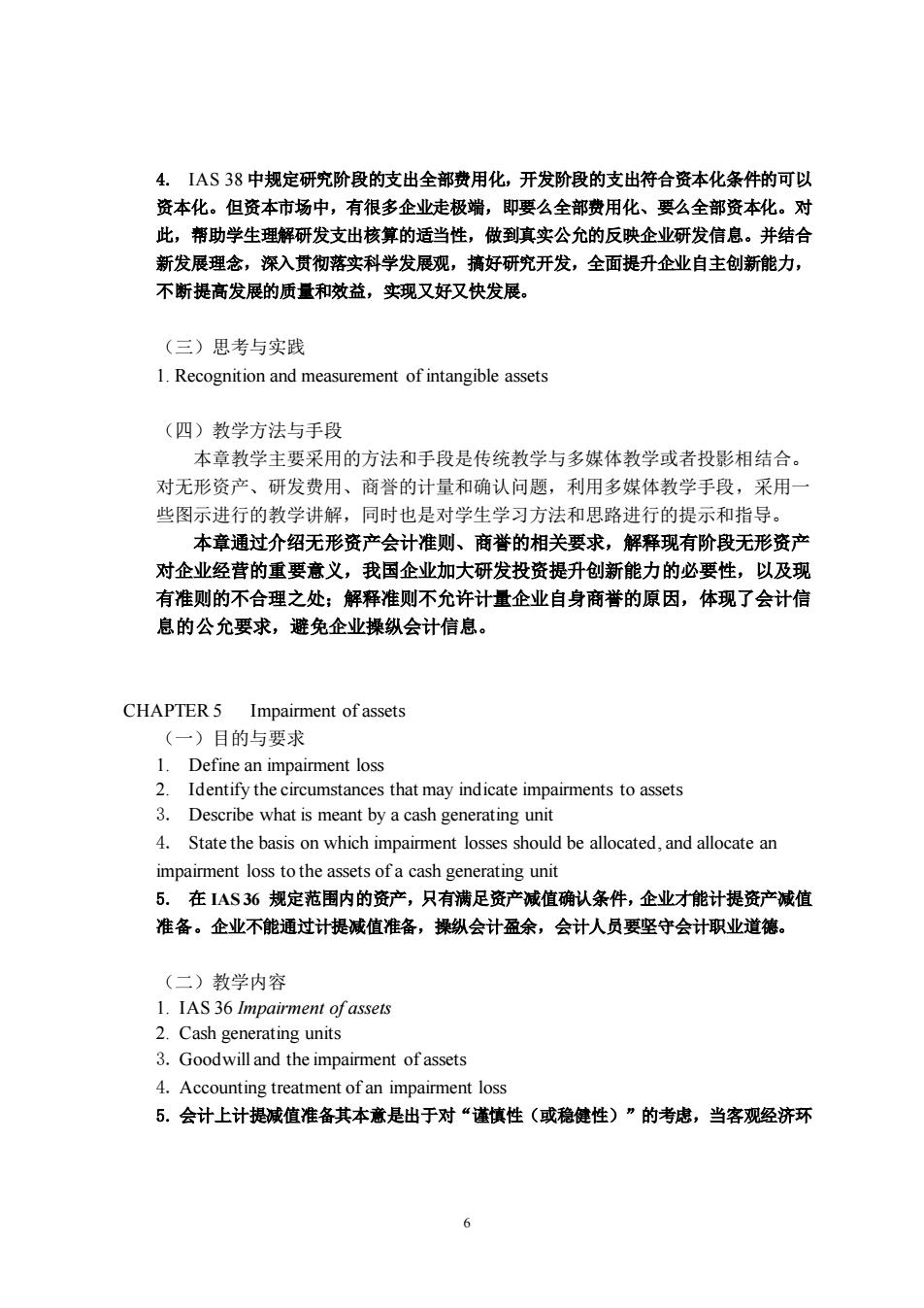
4.IAS38中规定研究阶段的支出全部费用化,开发阶段的支出符合资本化条件的可以 资本化。但资本市场中,有很多企业走极端,即要么全部费用化、要么全部资本化。对 此,帮助学生理解研发支出核算的适当性,做到真实公允的反映企业研发信息。并结合 新发展理念,深入贯彻落实科学发展观,搞好研究开发,全面提升企业自主创新能力, 不断提高发展的质量和效益,实现又好又快发展。 (三)思考与实践 1.Recognition and measurement of intangible assets (四)教学方法与手段 本章教学主要采用的方法和手段是传统教学与多媒体教学或者投影相结合。 对无形资产、研发费用、商誉的计量和确认问题,利用多媒体教学手段,采用 些图示进行的教学讲解,同时也是对学生学习方法和思路进行的提示和指导。 本章通过介绍无形资产会计准则、商誉的相关要求,解释现有阶段无形资产 对企业经营的重要意义,我国企业加大研发投资提升创新能力的必要性,以及现 有准则的不合理之处;解释准则不允许计量企业自身商誉的原因,体现了会计信 息的公允要求,避免企业操纵会计信息。 CHAPTER 5 Impairment of assets (一)目的与要求 1. Define an impairment loss 2.Identify the circumstances that may indicate impairments to assets Describe what is meant by a cash generating unit State the basis on which impairment losses should be allocated.and allocate an mpairment loss to the assets of a cash generating unit 5.在IAS6规定范围内的资产,只有满足资产减值确认条件,企业才能计提资产减值 准备。企业不能通过计提减值准备,操纵会计盈余,会计人员要坚守会计职业道德。 (二)教学内容 1.IAS 36 Impairment of assets 2.Cash generating units 3.Goodwill and the impairment ofassets 4.Accounting treatment ofan impairment loss 5。会计上计提减值准备其本意是出于对“谨慎性(或稳健性)”的考虑,当客观经济环 6
6 4. IAS 38 中规定研究阶段的支出全部费用化,开发阶段的支出符合资本化条件的可以 资本化。但资本市场中,有很多企业走极端,即要么全部费用化、要么全部资本化。对 此,帮助学生理解研发支出核算的适当性,做到真实公允的反映企业研发信息。并结合 新发展理念,深入贯彻落实科学发展观,搞好研究开发,全面提升企业自主创新能力, 不断提高发展的质量和效益,实现又好又快发展。 (三)思考与实践 1. Recognition and measurement of intangible assets (四)教学方法与手段 本章教学主要采用的方法和手段是传统教学与多媒体教学或者投影相结合。 对无形资产、研发费用、商誉的计量和确认问题,利用多媒体教学手段,采用一 些图示进行的教学讲解,同时也是对学生学习方法和思路进行的提示和指导。 本章通过介绍无形资产会计准则、商誉的相关要求,解释现有阶段无形资产 对企业经营的重要意义,我国企业加大研发投资提升创新能力的必要性,以及现 有准则的不合理之处;解释准则不允许计量企业自身商誉的原因,体现了会计信 息的公允要求,避免企业操纵会计信息。 CHAPTER 5 Impairment of assets (一)目的与要求 1. Define an impairment loss 2. Identify the circumstances that may indicate impairments to assets 3. Describe what is meant by a cash generating unit 4. State the basis on which impairment losses should be allocated, and allocate an impairment loss to the assets of a cash generating unit 5. 在 IAS 36 规定范围内的资产,只有满足资产减值确认条件,企业才能计提资产减值 准备。企业不能通过计提减值准备,操纵会计盈余,会计人员要坚守会计职业道德。 (二)教学内容 1. IAS 36 Impairment of assets 2. Cash generating units 3. Goodwill and the impairment of assets 4. Accounting treatment of an impairment loss 5. 会计上计提减值准备其本意是出于对“谨慎性(或稳健性)”的考虑,当客观经济环
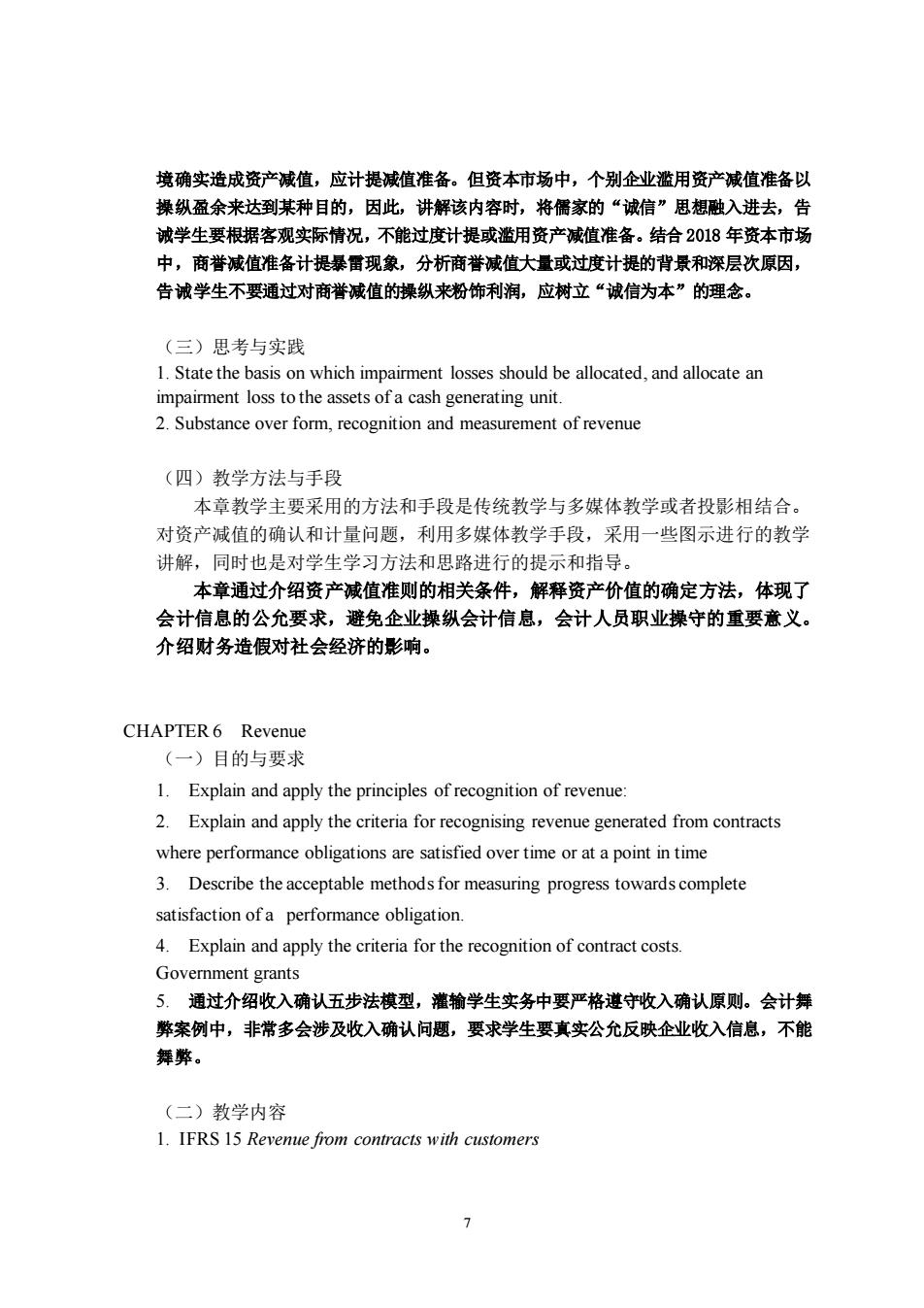
境确实造成资产减值,应计提减值准备。但资本市场中,个别企业滥用资产减值准备以 操纵盆余来达到某种目的,因此,讲解该内容时,将衢家的“诚信”思想融入进去,告 城学生要根据客观实际待况,不能过度计提或滥用资产减值准备。结合2018年资本市场 中,商誉减值准备计提暴雷现象,分析商誉减值大量或过度计提的背景和深层次原因, 告斌学生不要通过对商誉减值的操纵来粉饰利润,应树立“波信为本”的理念。 (二)思若与实践 1.State the basis on which impairment losses should be allocated,and allocate an impairment loss to the assets of a cash generating unit. 2.Substance over form.recognition and measurement of revenue (四)教学方法与手段 本章教学主要采用的方法和手段是传统教学与多媒体教学或者投影相结合。 对资产减值的确认和计量问题,利用多媒体教学手段,采用一些图示进行的教学 讲解,同时也是对学生学习方法和思路进行的提示和指导。 本章通过介绍资产诚值准则的相关条件,解释资产价值的确定方法,体现了 会计信息的公允要求,避免企业操纵会计信息,会计人员职业操守的重要意义。 介绍财务造假对社会经济的影响。 CHAPTER6 Revenue (一)目的与要求 1.Explain and apply the principles of recognition of revenue 2.Explain and apply the criteria for recognising revenue generated from contracts where performance obligations are satisfied over time or at a point in time 3.Describe the acceptable methods for measuring progress towardscomplete satisfaction of a performance obligation 4.Explain and apply the criteria for the recognition of contract costs. Government grants 5.通过介绍收入确认五步法模型,灌输学生实务中要严格遵守收入确认原则。会计舞 弊案例中,非常多会涉及收入确认问题,要求学生要真实公允反映企业收入信息,不能 舞弊。 (二)教学内容 1.IFRS 15 Revenue from contracts with customers 7
7 境确实造成资产减值,应计提减值准备。但资本市场中,个别企业滥用资产减值准备以 操纵盈余来达到某种目的,因此,讲解该内容时,将儒家的“诚信”思想融入进去,告 诫学生要根据客观实际情况,不能过度计提或滥用资产减值准备。结合 2018 年资本市场 中,商誉减值准备计提暴雷现象,分析商誉减值大量或过度计提的背景和深层次原因, 告诫学生不要通过对商誉减值的操纵来粉饰利润,应树立“诚信为本”的理念。 (三)思考与实践 1. State the basis on which impairment losses should be allocated, and allocate an impairment loss to the assets of a cash generating unit. 2. Substance over form, recognition and measurement of revenue (四)教学方法与手段 本章教学主要采用的方法和手段是传统教学与多媒体教学或者投影相结合。 对资产减值的确认和计量问题,利用多媒体教学手段,采用一些图示进行的教学 讲解,同时也是对学生学习方法和思路进行的提示和指导。 本章通过介绍资产减值准则的相关条件,解释资产价值的确定方法,体现了 会计信息的公允要求,避免企业操纵会计信息,会计人员职业操守的重要意义。 介绍财务造假对社会经济的影响。 CHAPTER 6 Revenue (一)目的与要求 1. Explain and apply the principles of recognition of revenue: 2. Explain and apply the criteria for recognising revenue generated from contracts where performance obligations are satisfied over time or at a point in time 3. Describe the acceptable methods for measuring progress towards complete satisfaction of a performance obligation. 4. Explain and apply the criteria for the recognition of contract costs. Government grants 5. 通过介绍收入确认五步法模型,灌输学生实务中要严格遵守收入确认原则。会计舞 弊案例中,非常多会涉及收入确认问题,要求学生要真实公允反映企业收入信息,不能 舞弊。 (二)教学内容 1. IFRS 15 Revenue from contracts with customers
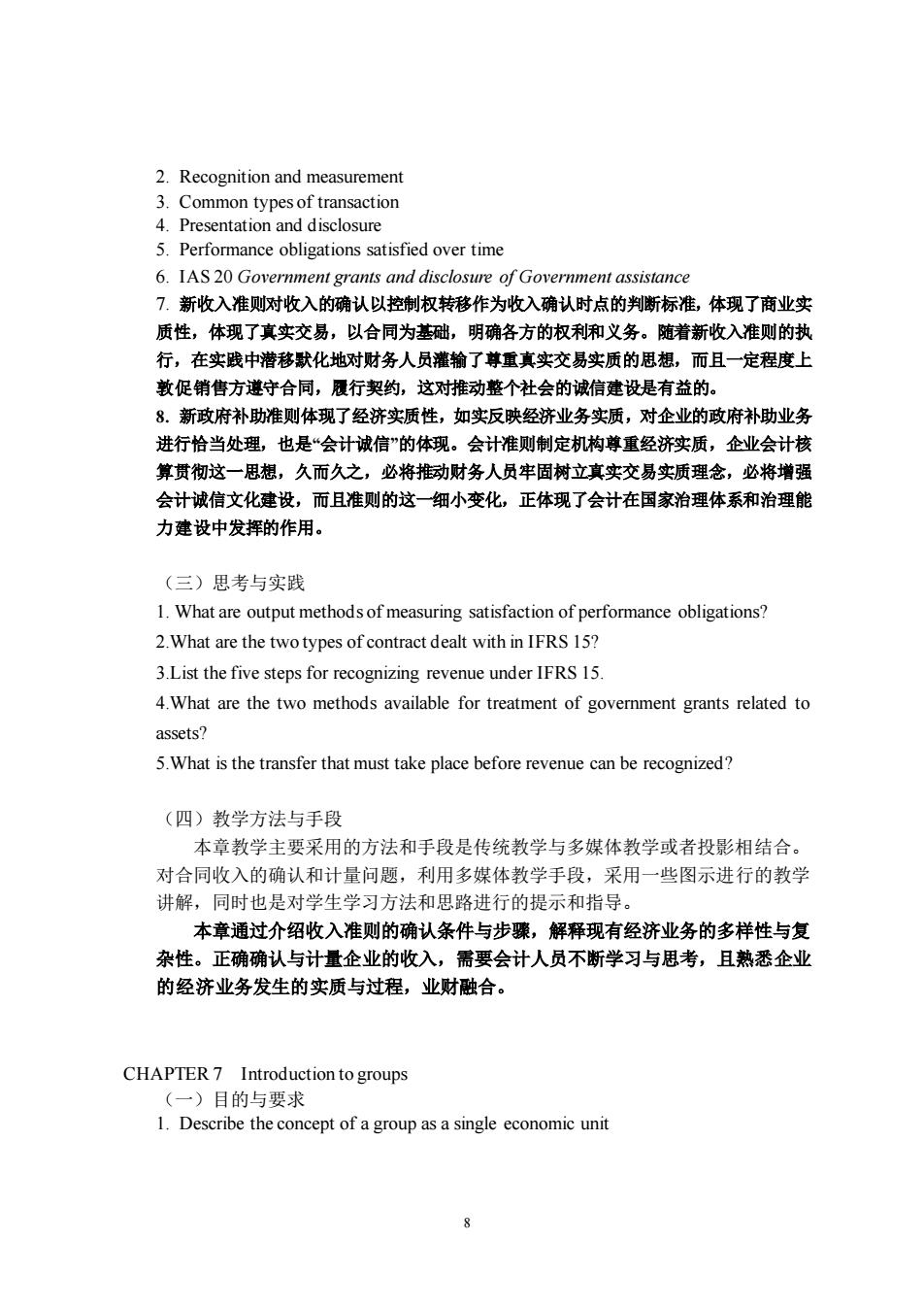
2.Recognition and measurement 3.Common types of transaction 4.Presentation and disclosure mmance obligations satisfied over time 6.IAS 20 Government grants and disclosure of Government assistance 7.新收入准则对收入的确认以控制权转移作为收入确认时点的判断标准,体现了商业实 质性,体现了真实交易,以合同为基础,明确各方的权利和义务。随着新收入准则的执 行,在实践中潜移默化地对财务人员灌输了尊重真实交易实质的思想,而且一定程度上 敦促销售方遵守合同,履行契约,这对推动整个社会的诚信建设是有益的。 8.新政府补助准则体现了经济实质性,如实反映经济业务实质,对企业的政府补助业务 进行恰当处理,也是“会计诚信”的体现。会计准则制定机构尊重经济实质,企业会计核 算贯彻这一思想,久而久之,必将推动财务人员牢固树立真实交易实质理念,必将增强 会计诚信文化建设,而且准则的这一细小变化,正体现了会计在国家治理体系和治理能 力建设中发挥的作用。 (三)思考与实践 1.What are output methods of measuring satisfaction of performance obligations? 2.What are the twotypes of contract dealt with in IFRS 15? 3.List the five steps for recognizing revenue under IFRS 15. 4.What are the two methods available for treatment of government grants related to assets? 5.What is the transfer that must take place before revenue can be recognized? (四)教学方法与手段 本章教学主要采用的方法和手段是传统教学与多媒体教学或者投影相结合。 对合同收入的确认和计量问题,利用多媒体教学手段,采用一些图示进行的教学 讲解,同时也是对学生学习方法和思路进行的提示和指导。 本章通过介绍收入准则的确认条件与步骤,解释现有经济业务的多样性与复 杂性。正确确认与计量企业的收入,需要会计人员不断学习与思考,且熟悉企业 的经济业务发生的实质与过程,业财融合。 Introduction to groups (一)目的与要求 1.Describe the concept of a group as a single economic unit 8
8 2. Recognition and measurement 3. Common types of transaction 4. Presentation and disclosure 5. Performance obligations satisfied over time 6. IAS 20 Government grants and disclosure of Government assistance 7. 新收入准则对收入的确认以控制权转移作为收入确认时点的判断标准,体现了商业实 质性,体现了真实交易,以合同为基础,明确各方的权利和义务。随着新收入准则的执 行,在实践中潜移默化地对财务人员灌输了尊重真实交易实质的思想,而且一定程度上 敦促销售方遵守合同,履行契约,这对推动整个社会的诚信建设是有益的。 8. 新政府补助准则体现了经济实质性,如实反映经济业务实质,对企业的政府补助业务 进行恰当处理,也是“会计诚信”的体现。会计准则制定机构尊重经济实质,企业会计核 算贯彻这一思想,久而久之,必将推动财务人员牢固树立真实交易实质理念,必将增强 会计诚信文化建设,而且准则的这一细小变化,正体现了会计在国家治理体系和治理能 力建设中发挥的作用。 (三)思考与实践 1. What are output methods of measuring satisfaction of performance obligations? 2.What are the two types of contract dealt with in IFRS 15? 3.List the five steps for recognizing revenue under IFRS 15. 4.What are the two methods available for treatment of government grants related to assets? 5.What is the transfer that must take place before revenue can be recognized? (四)教学方法与手段 本章教学主要采用的方法和手段是传统教学与多媒体教学或者投影相结合。 对合同收入的确认和计量问题,利用多媒体教学手段,采用一些图示进行的教学 讲解,同时也是对学生学习方法和思路进行的提示和指导。 本章通过介绍收入准则的确认条件与步骤,解释现有经济业务的多样性与复 杂性。正确确认与计量企业的收入,需要会计人员不断学习与思考,且熟悉企业 的经济业务发生的实质与过程,业财融合。 CHAPTER 7 Introduction to groups (一)目的与要求 1. Describe the concept of a group as a single economic unit

2.Explain and apply the definition of a subsidiary within relevant accounting 3.1d ntify and outline using accounting st eregulation the n a group required ed fi statements group n m the repaag wish ment solidate a subsidiary and when this is e ted by standards and othe plicable regulation 6 Explain the need fo otermino when preparing consolidated financial statements 7.Explain the objective of consolidated financial statements 8.正确理解母公司编制合并报表的合并范围,真实公允呈现企业集团财务状况、经营成果 的全貌,遵纪守法、强化责任担当, (二)教学内容 1 Groun accounts 2.Consolidated and separate financial statements Content of group acc unts and group structure 4。母公司编制合并报表的合并范围, 要以控制为判断依据,严格遵守准则规定。引用美 国安然事件作为案例,教导学生要敬畏法律、诚实守信、勇于担当社会责任。 (三)思考与实践 1.What accounting treatment does IFRS 10 require of a parent company? 2.How should an investment in a subsidiary be accounted for in the separate financial statements ofthe parent? 3.What is a non-controlling interest? (四)教学方法与手段 本章教学主要采用的方法和手段是传统教学与多媒体教学或者投影相结合。 对如何确认集团公司及合并财务报告问题,利用多媒体教学手段,采用一些图示 进行的教学讲解,同时也是对学生学习方法和思路进行的提示和指导。 本章通过介绍企业集团的特点,解释将一个企业集团作为一个会计主体提供 财务报表的必要性,避免企业采用设立多重子公司的形式,逃避法律监管,损害 投资者利益。 CHAPTER The consolidated statement of financial position (一)目的与要求 1.Explain why it is necessary to eliminate intra group transactions
9 2. Explain and apply the definition of a subsidiary within relevant accounting standards 3. Identify and outline using accounting standards and other applicable regulation the circumstances in which a group is required to prepare consolidated financial statements 4. Describe the circumstances when a group may claim exemption from the preparation of consolidated financial statements 5. Explain why directors may not wish to consolidate a subsidiary and when this is permitted by accounting standards and other applicable regulation 6. Explain the need for using coterminous year ends and uniform accounting policies when preparing consolidated financial statements 7. Explain the objective of consolidated financial statements 8. 正确理解母公司编制合并报表的合并范围,真实公允呈现企业集团财务状况、经营成果 的全貌,遵纪守法、强化责任担当。 (二)教学内容 1. Group accounts 2. Consolidated and separate financial statements 3. Content of group accounts and group structure 4. 母公司编制合并报表的合并范围,要以控制为判断依据,严格遵守准则规定。引用美 国安然事件作为案例,教导学生要敬畏法律、诚实守信、勇于担当社会责任。 (三)思考与实践 1.What accounting treatment does IFRS 10 require of a parent company? 2.How should an investment in a subsidiary be accounted for in the separate financial statements of the parent? 3.What is a non-controlling interest? (四)教学方法与手段 本章教学主要采用的方法和手段是传统教学与多媒体教学或者投影相结合。 对如何确认集团公司及合并财务报告问题,利用多媒体教学手段,采用一些图示 进行的教学讲解,同时也是对学生学习方法和思路进行的提示和指导。 本章通过介绍企业集团的特点,解释将一个企业集团作为一个会计主体提供 财务报表的必要性,避免企业采用设立多重子公司的形式,逃避法律监管,损害 投资者利益。 CHAPTER 8 The consolidated statement of financial position (一)目的与要求 1. Explain why it is necessary to eliminate intra group transactions
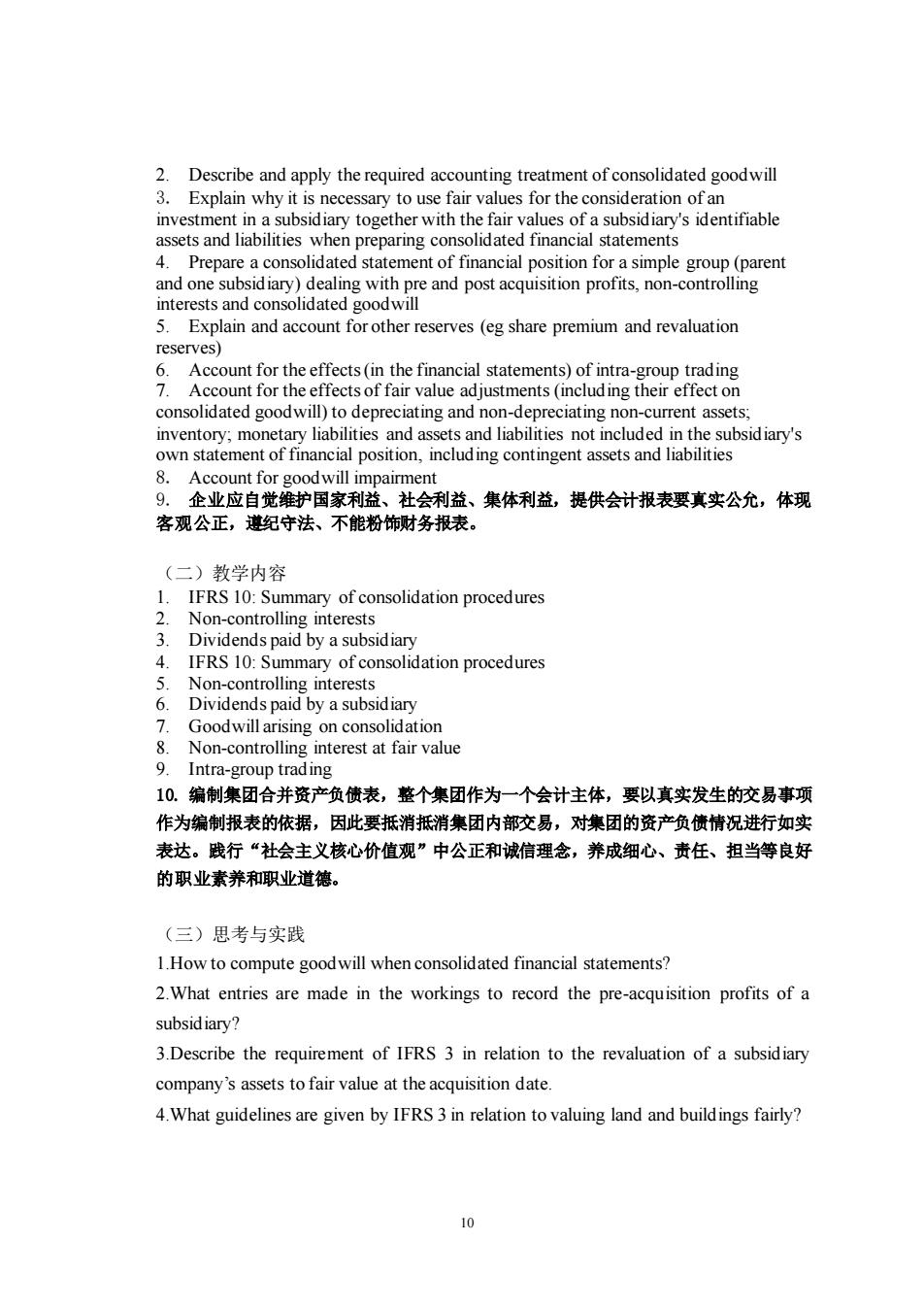
2 Describe and apply the required accounting treatment of consolidated goodwill Explain why it is necessary to use fair values for the consideration of an ary toge 0 a subsidiary's identifiable eparing coe po on to e group acquisition profits,non-contr ts and co pre and post Explain and account for other reserves (eg share premium and revaluation reserves) .coun or thefecto frasme (inunh Account for the effects (in the financial statements)of intra- oun trading consolidated goodwill)to depreciating and non-depreciating non-current assets; inventory;monetary liabilities and assets and liabilities not included in the subsidiary's own statement of financial position,including contingent assets and liabilities 8. Account for good will impairment 9. 企业应自觉维护国家利益、社会利益、集体利益,提供会计报表要真实公允,体现 客观公正,遵纪守法、不能粉饰财务报表。 (二)教学内容 N Summary of consolidation procedures mar of cons procedures Goodwill Non-controlling interest at fair value Intra oup trad ing 10.编制集团合并资产负债表,整个集团作为 一个会计主体,要以真实发生的较易事项 作为编制报表的依据,因此要抵消抵消集团内部交易,对集团的资产负债情况进行如实 表达。践行“社会主义核心价值观”中公正和诚信理念,养成细心、责任、担当等良好 的职业素养和职业道德。 (三)思考与实践 1.How to compute goodwill when consolidated financial statements? 2.What entries are made in the workings to record the pre-acquisition profits of a subsidiary? 3.Describe the requirement of IFRS 3 in relation to the revaluation of a subsidiary company's assets to fair value at the acquisition date. 4.What guidelines are given by IFRS3 in relation to valuing land and buildings fairly? 10
10 2. Describe and apply the required accounting treatment of consolidated goodwill 3. Explain why it is necessary to use fair values for the consideration of an investment in a subsidiary together with the fair values of a subsidiary's identifiable assets and liabilities when preparing consolidated financial statements 4. Prepare a consolidated statement of financial position for a simple group (parent and one subsidiary) dealing with pre and post acquisition profits, non-controlling interests and consolidated goodwill 5. Explain and account for other reserves (eg share premium and revaluation reserves) 6. Account for the effects (in the financial statements) of intra-group trading 7. Account for the effects of fair value adjustments (including their effect on consolidated goodwill) to depreciating and non-depreciating non-current assets; inventory; monetary liabilities and assets and liabilities not included in the subsidiary's own statement of financial position, including contingent assets and liabilities 8. Account for goodwill impairment 9. 企业应自觉维护国家利益、社会利益、集体利益,提供会计报表要真实公允,体现 客观公正,遵纪守法、不能粉饰财务报表。 (二)教学内容 1. IFRS 10: Summary of consolidation procedures 2. Non-controlling interests 3. Dividends paid by a subsidiary 4. IFRS 10: Summary of consolidation procedures 5. Non-controlling interests 6. Dividends paid by a subsidiary 7. Goodwill arising on consolidation 8. Non-controlling interest at fair value 9. Intra-group trading 10. 编制集团合并资产负债表,整个集团作为一个会计主体,要以真实发生的交易事项 作为编制报表的依据,因此要抵消抵消集团内部交易,对集团的资产负债情况进行如实 表达。践行“社会主义核心价值观”中公正和诚信理念,养成细心、责任、担当等良好 的职业素养和职业道德。 (三)思考与实践 1.How to compute goodwill when consolidated financial statements? 2.What entries are made in the workings to record the pre-acquisition profits of a subsidiary? 3.Describe the requirement of IFRS 3 in relation to the revaluation of a subsidiary company’s assets to fair value at the acquisition date. 4.What guidelines are given by IFRS 3 in relation to valuing land and buildings fairly?